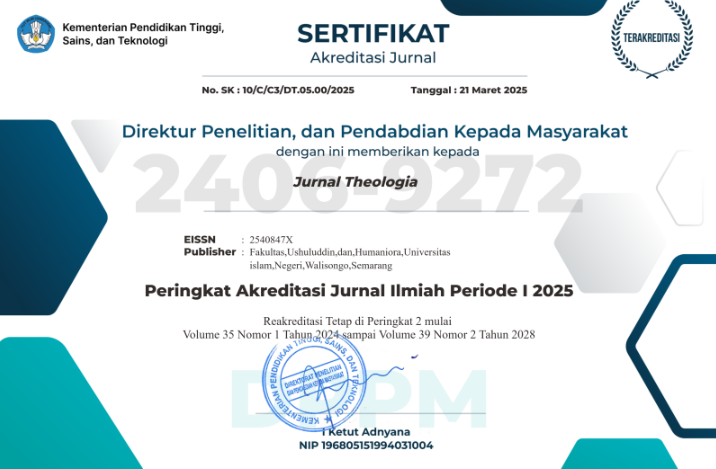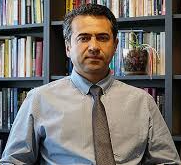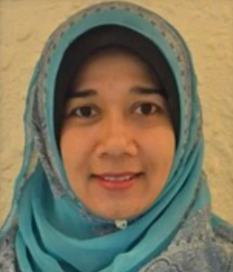Religious Challenges and Guidance for Dayak Muslim Converts in the Indonesia–Malaysia Border Region
DOI:
https://doi.org/10.21580/teo.2025.36.1.26839Keywords:
Dayak Muslim Converts, Religious Syncretism, Religious Moderation, Borderland Communities, Contextual Islamic GuidanceAbstract
Religious conversion in border areas often triggers complex identity negotiations and social tension, particularly for indigenous communities like the Dayak people. In Jagoi Village, located at the Indonesia–Malaysia border, many Dayak individuals who convert to Islam face cultural, social, and spiritual challenges due to their minority status and the persistence of traditional customs. This study aims to identify the religious issues encountered by Dayak Muslim converts and evaluate the strategies of religious guidance based on religious moderation. Using a qualitative case study approach, data were collected through in-depth interviews, focus group discussions, and field observations involving religious counselors and local converts. The findings reveal four major problems: limited Islamic knowledge, minimal religious mentoring, poor access to digital Islamic resources, and a lack of understanding of religious moderation. This research contributes to the discourse on minority religious identity and offers policy recommendations for inclusive, culturally sensitive religious mentoring. It also supports the design of empowerment models for Muslim converts in border areas, which can serve as a reference for interreligious engagement and social integration efforts in Southeast Asia's plural societies.
Downloads
References
Abdullah, R., Jayos, S., Fatahyah, Y., Bandar, N. F. A., Yusoff, N. F. M., & Ifdil, I. (2022). Adaptation Strategies by Muslim Convert: A Study on “Saudara Kita” in Sarawak Malaysia. Islamic Guidance and Counseling Journal, 5(2), 185–204. https://doi.org/10.25217/igcj.v5i2.2480
Adhikari, A., Shrestha, B., K.C., R., Nyaupane, S., & Karn, A. (2023). Association Between Socio-Demographic Characteristics and Women’s Knowledge of Human Trafficking. Journal of Health Promotion, 11(1), 62–74. https://doi.org/10.3126/jhp.v11i1.61204
Amin, F. (2020). Manuskrip Koleksi Abang Ahmad Tahir Kapuas Hulu: Kajian Teks Dan Parateks Tentang Konstruksi Identitas Dayak Islam Pada Awal Abad Ke-20.
Aprilianti, E. (2024). Integrating Islamic Psychological Principles in Enhancing Students’ Academic Resilience. Nusant. J. Behav. And. Soc. Sci, 3(2), 63–72. https://doi.org/10.47679/202246
Aranha, S., & Rampazzo, L. (2022). Towards a Working Definition of Negotiation in Telecollaboration: Analysis of Teletandem Oral Sessions. Colombian Applied Linguistics Journal, 24(2). https://doi.org/10.14483/22487085.17191
Aulia, F., & Arifin, F. (2023). Moderasi Beragama Dalam Ruang Digital: Studi Harmonisasi Moderasi Beragama Di Perguruan Tinggi Keagamaan Islam Negeri. MODERATIO: Jurnal Moderasi Beragama, 3(2), 205–217.
Ayten, A., Kılınçer, H., Ulu, N., İşbilen, N., & Albayrak, H. (2019). Formation and Consequences of the Conversion Process: A Qualitative Study of Adult Converts. Ilahiyat Studies, 10(2), 141–181. https://doi.org/10.12730/13091719.2019.102.194
Bachrong, F., & Karim, Abd. (2022). Assilessureng and Assijigeng: The Concept of Religious Moderation Tomanurunge ri Bacukiki. Al-Qalam, 28(1), 78. https://doi.org/10.31969/alq.v28i1.1031
Carandang, R. R., Shibanuma, A., Kiriya, J., Vardeleon, K. R., Marges, M. A., Asis, E., Murayama, H., & Jimba, M. (2019). Leadership and Peer Counseling Program: Evaluation of Training and Its Impact on Filipino Senior Peer Counselors. International Journal of Environmental Research and Public Health, 16(21), 4108. https://doi.org/10.3390/ijerph16214108
Dariyo, A. (2021). Conversion Of Religion In Muslim Marriage Lives. Psikis : Jurnal Psikologi Islami, 7(1). https://doi.org/10.19109/psikis.v7i1.7481
Darmawani, E., Suryahadikusumah, A. R., Nurlela, N., & Surtiyoni, E. (2021). Contribution of Religious Moderation Among Multicultural Counseling Competence. Jurnal Konseling Dan Pendidikan, 9(4), 338. https://doi.org/10.29210/167100
Dawi, K., Haryono, D., Yuliastini, A., & Astono, A. (2022). Restorative Justice Paradigm of Kanayat’n Dayak Customary Law on Environmental Damage Caused by Shifting Cultivation. Jurnal Analisis Hukum, 5(2), 245–252. https://doi.org/10.38043/jah.v5i2.3918
Derks, F., & Sremac, S. (2020). Negotiating the Sacred: The Lived Religion of Eritrean Newcomers and Their Process of Integration in the Netherlands. Practical Theology, 13(6), 594–608. https://doi.org/10.1080/1756073x.2020.1792638
Diaków, D. M., & Goforth, A. N. (2021). Supporting Muslim Refugee Youth During Displacement: Implications for International School Psychologists. School Psychology International, 42(3), 238–258. https://doi.org/10.1177/0143034320987280
Dove, M. R. (2006). “New Barbarism” or Old Agency among the Dayak? Reflections on Post-Suharto Ethnic Violence in Kalimantan. Social Analysis, 50(1). https://doi.org/10.3167/015597706780886166
Duile, T. (2017). Being Dayak in West Kalimantan: Constructing Indigenous Identity as a Political and Cultural Resource. In Continuity under Change in Dayak Societies (pp. 123–140). Springer Fachmedien Wiesbaden. https://doi.org/10.1007/978-3-658-18295-3_5
Fahmi, M. R., & Muhyiddin, A. (2023). The Existence of Kaharingan Within Dayak Identity in West Kalimantan. Al-Albab, 12(1), 113–132. https://doi.org/10.24260/alalbab.v12i1.2662
Faoziyah, S. (2022). Community Empowerment Through Religious Education and Islamic Social-Resilience. Dinamika Ilmu, 293–316. https://doi.org/10.21093/di.v22i2.4967
GEZER, U., & Karagözoğlu, N. (2023). Examining the Relationship Between Teachers’ Levels of Digital Literacy and Their Attitudes Towards Distance Education. TAY Journal, 7(1), 204–231. https://doi.org/10.29329/tayjournal.2023.537.10
Großmann, K. (2019). ‘Dayak, Wake Up.’ Bijdragen Tot de Taal-, Land- En Volkenkunde, 175(1), 1–28. https://doi.org/10.1163/22134379-17501021
Halafoff, A., Singleton, A., Bouma, G. D., & Rasmussen, M. L. (2019). Religious Literacy of Australia’s Gen Z Teens: Diversity and Social Inclusion. Journal of Beliefs and Values, 41(2), 195–213. https://doi.org/10.1080/13617672.2019.1698862
Halim, A., Basyid, Abd., & Prihananto, P. (2021). RELIGIOUS IDENTITY TRANSFORMATION: Cultural Interbreeding Between Dayak Indigenous Culture and Islam. Journal of Indonesian Islam, 15(1), 171. https://doi.org/10.15642/jiis.2021.15.1.171-192
Hanif, M. A., Siahaan, G. B., & Nisa, V. K. (2022). Prevalence of Underweight, Stunting, and Wasting in Under-Five Children of Kuwiran Village, Madiun Regency, Indonesia: August 2022. International Journal of Research Publications, 113(1). https://doi.org/10.47119/ijrp10011311120214147
Haris, M. A., Salikin, A. D., Sahrodi, J., & Fatimah, S. (2023). Religious Moderation Among the Nahdlatul Ulama and Muhammadiyah. International Journal of Social Science and Human Research, 06(01). https://doi.org/10.47191/ijsshr/v6-i1-63
Hashemi, N., Marzban, M., Sebar, B., & Harris, N. (2020). Religious Identity and Psychological Well-Being Among Middle-Eastern Migrants in Australia: The Mediating Role of Perceived Social Support, Social Connectedness, and Perceived Discrimination. Psychology of Religion and Spirituality, 12(4), 475–486. https://doi.org/10.1037/rel0000287
Héliot, Y., Gleibs, I. H., Coyle, A., Rousseau, D. M., & Rojon, C. (2019). Religious Identity in the Workplace: A Systematic Review, Research Agenda, and Practical Implications. Human Resource Management, 59(2), 153–173. https://doi.org/10.1002/hrm.21983
Herdiansyah, H., & Rizki, M. N. (2021). Restoration and Conservation Based on Community Empowerment and Religious Understanding. Iop Conference Series Earth and Environmental Science, 940(1), 012079. https://doi.org/10.1088/1755-1315/940/1/012079
Hidajah, A. C., & Astutik, E. (2023). Analysis of Diarrhea Management in Children Under Two Years Old in Indonesia. Jurnal Berkala Epidemiologi, 11(2), 198–204. https://doi.org/10.20473/jbe.v11i22023.198-204
Ilhami, R. (2023). Stakeholder Analysis in Maternal and Child Health Policy in Subang Regency. Best Journal of Administration and Management, 2(2), 96–103. https://doi.org/10.56403/bejam.v2i2.144
Isaeva, V. B. (2019). Religious Conversion as a Criterion for the Efficiency of Management Strategies in Late Imperial Russia. Vestnik of Saint Petersburg University. History, 64(4), 1257–1271. https://doi.org/10.21638/11701/spbu02.2019.406
Jafari, A., & Süerdem, A. (2012). An Analysis of Material Consumption Culture in the Muslim World. Marketing Theory, 12(1), 61–79. https://doi.org/10.1177/1470593111424184
Khan, N. (2021). A Qualitative Exploration of Systemic Training and Practice for Muslim Community Leaders as Part of an Innovative Project in an Inner‐city Area. Journal of Family Therapy, 44(1), 124–141. https://doi.org/10.1111/1467-6427.12378
Kitching, E., Mullen, P. R., Chae, N., & Backer, A. (2024). School Counselors’ Experiences of Induction and Mentoring. Professional School Counseling, 28(1). https://doi.org/10.1177/2156759x241290492
Koloszko-Chomentowska, Z., & Sieczko, L. (2018, May 23). Peripheral rural areas in face of challenges of sustainable development. https://doi.org/10.22616/ERDev2018.17.N277
König, A. (2016). Identity Constructions and Dayak Ethnic Strife in West Kalimantan, Indonesia. The Asia Pacific Journal of Anthropology, 17(2), 121–137. https://doi.org/10.1080/14442213.2016.1146917
Kupriyanov, S. V., Stryabkova, E. A., & Gerasimova, N. A. (2018). FEATURES OF ECONOMIC DEVELOPMENT OF BORDER REGIONS. Scientific Bulletins of the Belgorod State University. Series: Economics. Computer Science, 45(1), 5–14. https://doi.org/10.18413/2411-3808-2018-45-1-5-14
Lopez‐Perry, C. (2020). Transformational Leadership and the Big Five Personality Traits of Counselor Educators. Journal of Counselor Leadership and Advocacy, 7(2), 132–146. https://doi.org/10.1080/2326716x.2020.1820406
Madjid, A., Latief, H., & Santoso, S. (2020). Penguatan Sikap Beragama Pada Kaum Mualaf Suku Akit Desa Penyengat Kabupaten Siak. JMM (Jurnal Masyarakat Mandiri), 4(4), 633–645.
Mao, Y., He, L., Danniswari, D., & Furuya, K. (2023). College Students’ Perceptions of and Place Attachment to Rural Areas: Case Study of Japan and China. Youth, 3(2), 737–752. https://doi.org/10.3390/youth3020048
Marisa, W., & Djulia, E. (2022). The Relationship of Digital Literacy to Students’ Cognitive Ability in Ecology Course. Jurnal Pelita Pendidikan, 10(2). https://doi.org/10.24114/jpp.v10i2.26774
Marlina, W. A. (2023). Quality Control of Cement Bags Using Pareto Diagrams and Analytical Hierarchy Process (AHP). Jurnal Manajemen, 14(3), 455–470. https://doi.org/10.32832/jm-uika.v14i3.9048
Milner, A. (2023). The Timing of Islamization in Southeast Asia: Local Agency, and the Challenge of Analysing Religious Conversion. Journal of the Malaysian Branch of the Royal Asiatic Society, 96(1), 21–49. https://doi.org/10.1353/ras.2023.a900783
Mythen, G. (2012). Identities in the Third Space? Solidity, Elasticity and Resilience Amongst Young British Pakistani Muslims. British Journal of Sociology, 63(3), 393–411. https://doi.org/10.1111/j.1468-4446.2012.01416.x
Nurdin, A., & Muhammad, Z. (2022). Analysis of Government Policy in Reducing Stunting Rate at Aceh Jaya, Indonesia. International Journal of Advances in Social Sciences and Humanities, 1(4), 187–196. https://doi.org/10.56225/ijassh.v1i4.95
Nurjanah, N. T., & Haryani, L. (2020). Efektivitas Pembinaan Keagamaan Islam Di Kampung Skouw Sae Distrik Muara Tami Perbatasan RI-PNG. POROS ONIM: Jurnal Sosial Keagamaan, 1(1), 49–66.
Omar, M. K., Dainal, E., Puad, M. H. M., & Zakaria, A. (2023). Factors Determining the Optimization of Digital Technology in Rural Schools. International Journal of Academic Research in Progressive Education and Development, 12(1). https://doi.org/10.6007/ijarped/v12-i1/16559
Pambudi, A. S., Moersidik, S. S., & Karuniasa, M. (2021). Analysis of Recent Erosion Hazard Levels and Conservation Policy Recommendations for Lesti Subwatershed, Upper Brantas Watershed. Jurnal Perencanaan Pembangunan the Indonesian Journal of Development Planning, 5(1), 71–93. https://doi.org/10.36574/jpp.v5i1.167
Paoliello, A. (2019). Becoming Muslim or Becoming Malay? Conversion to Islam in Two Sinophone Malaysian Short Stories. Canadian Review of Comparative Literature / Revue Canadienne de Littérature Comparée, 46(3), 470–487. https://doi.org/10.1353/crc.2019.0031
Quraishi, T., Ulusi, H., MUHID, A., Hakimi, M., & OLUSI, M. R. (2024). Empowering Students Through Digital Literacy: A Case Study of Successful Integration in a Higher Education Curriculum. Journal of Digital Learning and Distance Education, 2(8), 667–681. https://doi.org/10.56778/jdlde.v2i8.208
Ramadhanu, A., & Widiastuti, T. (2017). Model pemberdayaan ekonomi mualaf oleh lembaga amil zakat: studi kasus LAZ BMH pada mualaf Suku Tengger. Jurnal Ekonomi Syariah Teori Dan Terapan, 4(4), 315179.
Rasmitadila, R., Humaira, M. A., Prasetyo, T., Hasnin, H. D., & Rachmadtullah, R. (2023). Teacher Perceptions of Inclusive Education Training: Implementation of an Inclusive Elementary School Mentoring Program Based on Collaborative Partnership. Journal of Education and E-Learning Research, 10(4), 682–688. https://doi.org/10.20448/jeelr.v10i4.5054
Revaldi, M., Faridah, S., & Musfichin, M. (2024). Prosocial Behavior in the Dayak Ethnicity in Central Kalimantan Province. Winter Journal, 4(2), 166–173. https://doi.org/10.52851/wt.v4i2.58
Rizal, M., & Hamzah, D. F. (2023). The Synergy of the Religious Role in Supporting the Accelerated Reduction of Stunting in Kutaraja District, Banda Aceh. Jurnal Sago Gizi Dan Kesehatan, 5(1), 234. https://doi.org/10.30867/gikes.v5i1.1389
Sabna, S., Abidin, Z., & Azma, A. (2024). Dynamics of Religious Conversion From Islamic Education Perspective: Study at the Central Sulawesi Regional Center for Mualaf Foundation. International Journal of Innovative Research in Multidisciplinary Education, 03(09). https://doi.org/10.58806/ijirme.2024.v3i9n09
Segal, R. A. (2012). Clifford Geertz’s Interpretive Approach to Religion. Religion Compass, 6(12), 511–524. https://doi.org/10.1111/j.1749-8171.2012.00358.x
Shahar, R. N. (2016). Negotiating Agency: Amish and Ultra-Orthodox Women’s Responses to the Internet. New Media & Society, 19(1), 81–95. https://doi.org/10.1177/1461444816649920
Shakya, P., Kunieda, M., Koyama, M., Sing, S., Miyaguchi, M., Dhakal, S., Sandy, S., Sunguya, B., & Jimba, M. (2017). Effectiveness of Community-Based Peer Support for Mothers to Improve Their Breastfeeding Practices: A Systematic Review and Meta-Analysis. Plos One, 12(5), e0177434. https://doi.org/10.1371/journal.pone.0177434
Syafruddin, A., & Permatasari, T. A. E. (2023). Knowledge and Compliance of COVID-19 Health Protocols Among Pregnant Women in Urban and Rural West Java Province. Jurnal Aisyah Jurnal Ilmu Kesehatan, 8(2). https://doi.org/10.30604/jika.v8i2.1826
Syaikhon, S. H. I. D. M., Djuwari, D., Asmara, B., Fitriyah, F. K., Saleh, N. R., & Hardiningrum, A. (2023). Empowerment of Educators and Parents in Increasing the Value of Religious Moderation in Early Childhood. Community Development Journal, 7(3), 148–152. https://doi.org/10.33086/cdj.v7i3.5362
Tahara, T. (2023). Cultural Resilience and Syncretism: The Towani Tolotang Community’s Journey in Indonesia’s Religious Landscape. Journal of Ethnic and Cultural Studies, 10(4), 233–246. https://doi.org/10.29333/ejecs/1863
Talaallayna, N., & Winarti, N. (2024). Collaborative Governance in Overcoming Tuberculosis Cases in the Riau Islands Province. Ilomata International Journal of Social Science, 5(2), 615–627. https://doi.org/10.61194/ijss.v5i2.1225
Tsao, T. (2016). Indigenous Agency and Compliance: Contemporary Literature about Dayaks. PMLA/Publications of the Modern Language Association of America, 131(3), 686–700. https://doi.org/10.1632/pmla.2016.131.3.686
Uzun, S., Meydan, A., Devrilmez, E., & Uzun, A. (2023). The Relationship Between Teachers Attitudes Towards Distance Education and Their Digital Literacy Levels. Journal of Pedagogical Research. https://doi.org/10.33902/jpr.202322499
Yuswanto, F., Aryani, S. A., & Muttaqin, A. (2023). Pinah Laman: The Construction of Religious and Ethnic Identity Within the Mentuka Dayak of West Kalimantan. Al-Albab, 11(2), 177–198. https://doi.org/10.24260/alalbab.v11i2.2245
Zainuri, L. H. (2018). Dayak Lundayeh: A Report from The Border. CLCWeb: Comparative Literature and Culture, 20(2). https://doi.org/10.7771/1481-4374.3233
Downloads
Published
How to Cite
Issue
Section
License
Copyright (c) 2025 Moch Riza Fahmi Masri, Sri Hidayati, Zaenuddin Hudi Prasojo, Zulkifli Abdillah, Habib Zarbaliyev

This work is licensed under a Creative Commons Attribution-NonCommercial-ShareAlike 4.0 International License.





















